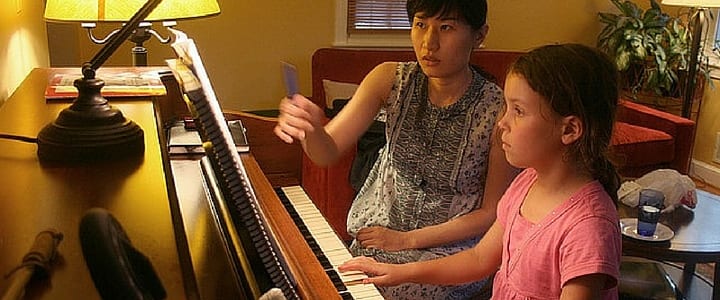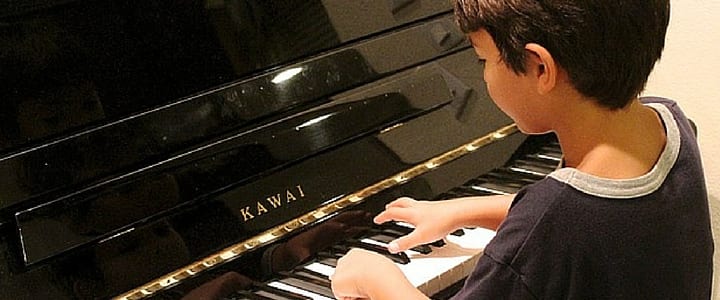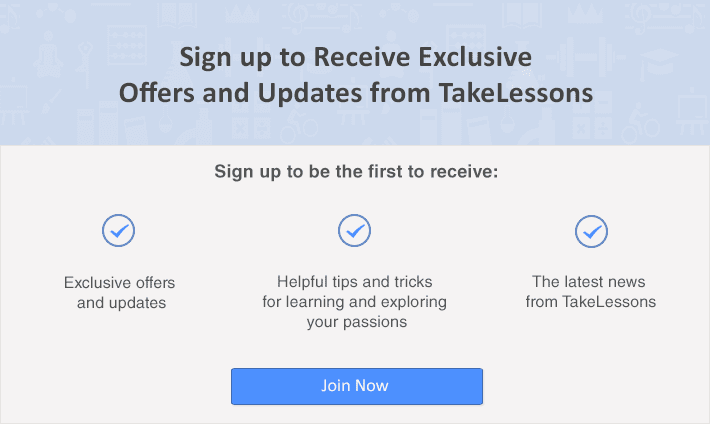No two piano students are the same. As a teacher, it’s important to take a unique approach to teaching different age groups. Below, piano teacher Rhonda B. shares some helpful tips on how to teach piano to every age group…
Imagine a department store where every item of women’s clothing is labeled size small. The store’s designer has decided on a certain ideal, and that’s what’s offered. If you don’t like it, you’re obviously ignorant of good taste.
As silly as this seems, that’s the exact approach many piano teachers take to teaching piano—a one-size-fits-all method. Take it or leave it. I say, leave it. Instead, our pedagogy should be willing to address all sorts of variables.
That being said, here are some helpful tips on how to teach piano to different ages groups. Not only are these tips helpful for piano teachers, but they are also helpful for parents who are helping their young musicians practice.
How to Teach Piano to Preschoolers
Preschoolers can be a rambunctious group of individuals who are difficult to teach. Below are some actionable tips on how to teach piano to preschoolers.
- Use appealing, kid-oriented songs: I’ve tried a number of books for young beginners, and keep coming back to “My First Piano Adventure” by Faber and Faber. Kids love the music featured in the book. For example, the book includes popular children’s songs, classical themes, and silly songs about “Dinosaur Music Night” at school.
- Get them moving: Preschoolers were made to dance, sing, change positions, and play games. My student Grady and I stay at the piano just long enough to perform his pieces. Then we move down to the rug for workbook time. We jump up and down every time I play high notes. We march around the room with rhythm instruments.
- Use a variety of approaches: Keep things interesting by using a variety of approaches. My student Zeke, for example, is a whiz at learning by ear, so we record some assignments on his mom’s mobile phone and he works them out by listening. Other students prefer to read the notes, and we sightread, instead.
- Break down new music into manageable sections: My young student Laura has trouble with rhythm, so we always clap and count a piece aloud before we play it. With the note values firmly in mind, she’s ready to tackle note reading. Younger students tend to get overwhelmed by complex concepts, so be sure to break them down into more manageable sections.
- Keep it light-hearted and fun: When it comes to teaching piano to preschoolers, you have to make learning fun and engaging. Edgar, who is autistic, loves race cars, so every week we start with an improvisation of a racing car crash. Edgar plays loud glissandos and shows me, on the piano, how the wrecked car turns over and over.
How to Teach Piano to Teens
Because teenagers are involved in so many activities, they can easily get burnt out while learning to play the piano. Below are some helpful tips on how to teach kids piano.
- Give them plenty of repertoire options: My teen students and I set goals at the beginning of each semester, and that includes the pieces they want to study. My student Olivia, for example, enjoys classical studies, while Ryan concentrates on the blues. Jairin plans to become a worship pastor, so his piano lessons center around contemporary Christian music and composition.
- Overlap lessons so they share time with other teens: Adolescents love to socialize. I try to schedule two high schoolers back-to-back so they share 10 minutes together weekly. They enjoy playing piano duets, and ear-training with each other.
- Work with their school and activities schedules: Several of my teens play in orchestra, band, or their church’s worship team. Therefore, make sure you work in tandem with their activities outside of lessons. When Phillip and Mackenzie are working up the required new pieces, for example, we focus mostly on those. Then, later in the year we return to other goals.
- Encourage them to explore their creativity: Teens are bursting with creativity. My student Becca, for example, writes beautiful compositions. We work on getting ideas started during her lesson times, and she develops them during her weekly practice time.
- Teach them how to get fast results: Few students know how to practice effectively, so I teach students like 17-year-old Tori how to play straight through music slowly with metronome, make note of mistakes, drill problem areas, and work up each piece quickly.
How to Teach Piano to Adults
Results are important to adult piano students. To ensure that you deliver results, follow these tips on how to teach piano to adults below.
- Offer them maximum choice: My senior citizen student Tom knows exactly what he wants to learn: Beatles music, jazz style, and note reading for popular songs. Therefore, I focus mostly on his choices, which makes us both happy. To keep adult piano students engaged, offer them several different choices.
- Help them set attainable goals: Adults need to feel in control of their lessons. Amy, a middle-aged woman with a chronic illness, can only practice sometimes, so her goals are flexible. In each lesson I ask her, “What did you work on this week?” and we go from there. Help your student set attainable goals that are realistic to their situation.
- Explain your goals as a teacher, and refer to them often: I take time to show students the benefits of, say, five-finger pattern drills: finger strength, but also a knowledge of major and minor chords. This helps adults understand that they can transfer their theory and technical studies to help with pieces they want to play.
- Schedule them for performances: Many of my adult students play in LHS’s annual coffee house and classical recitals. We also encourage them to perform for family gatherings, parties, church groups, and more. In doing so, they are more motivated to perfect their pieces.
- Make the lessons encouraging: Adults, in particular, need to know they’re making progress in lessons. I make it a point to (sincerely) praise their strong points and positively address their weaknesses so they can improve and gain confidence.
Many piano teaching principles are constants, non-negotiables we should continue to practice. However, we should also keep in mind individual needs, especially for different age groups.
While some of your students may fit perfectly into size small clothing, others need mediums and larges. In teaching piano, there is no “one-size-fits-all” approach–and that’s good.
Photo by Woodleywonderworks
Rhonda B. has taught piano for 20+ years in two piano schools and now at her home studio. She has a B.A. in Music Education from Culver-Stockton College, and studied post-graduate piano with instructors at Truman State University. Rhonda operates Listening House Studios in St. Charles, Missouri with her son and business partner Eric B. Book lessons here!
The post How to Teach Piano to Every Age Group (Preschoolers, Teens, and Adults) appeared first on | TakeLessons.




